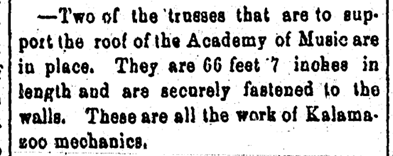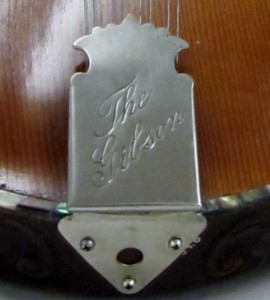Only Orvilles in the Building
.
The Academy of Music opened its doors on May 8, 1882 to an illustrious crowd of theater goers from all over the State of Michigan. Reviews of the opening night were printed in major newspapers including the Chicago Tribune. But how the theater got there in the first place is a story in itself.

Rumors of building a new opera house began to appear in the local newspapers in January of 1880. The first known public meeting, where a committee was formed to take action, was held at Corporation Hall in March of 1881. They must have done their homework thoroughly in advance because by the time they arrived at this meeting, they had a plan already laid out.
The newly formed ‘Kalamazoo Opera House Company’ was made of up attorneys, doctors, several retired military brass and some local businessmen. His Honorable Judge Peyton Ranney was voted President and William L. Eaton of the Kalamazoo Telegraph (and charity stage brother of Orville) was voted secretary.
They decided to raise money by selling stock in the Academy and selling opening night tickets for $5.00. Remember, even tickets for national theater troupes went for .35 cents, .50 cents, and .75 cents. The sales committee was made up of the local vaudeville community; Frank Knappen, Charles H. Caryl, George S. Parsons, Hutson B. Colman, Edgar Bartlett, Horace Cornell and Dan Cohn, just to name a few. These are all people you will meet in my book.
Not to throw Union Hall under the bus, but the Kalamazoo Opera House Company believed that the village of Kalamazoo “had outlived its present accommodations and their condition,” meaning Union Hall. Stating that “Many people refuse to patronize any entertainment in the present building, it being unsafe in case of panic.” And that “many people here have so great an aversion to Union Hall and its condition that they haven’t been there for several years.” They also mentioned its unsanitary condition mainly due to it having no ventilation whatsoever.
As we soon discover, their plans address these very issues first and foremost. It goes without saying that they wanted a modern, attractive building, but specifically, a newly designed slanting audience floor, adequate ventilation, proper heating and a first floor location. Plus a number of other modern conveniences.

The committee decided upon the property of Pelic Stevens on South Rose Street across from Bronson Park. Peyton Ranney bought the St. Nicholas boarding house which sat upon that property. The smaller back part of the structure was moved first. The larger front part got as far as Rose and Cedar Street where it sat for a few days because it was tearing up the old growth trees on each side of the street. After Peyton Ranney returned from out of town, it was decided to cut this front section in half so it could continue on its journey. The St. Nicholas boarding house was moved to the southeast corner of Westnedge and Vine where it still sits today.
Meanwhile, the theater portion of Union Hall had changed hands and was being thoroughly remodeled. In addition, there was a tug of war going on about which theater was going to call itself the “Opera House.” The proprietors of the newly remodeled Union Hall had already began advertising it as the “Kalamazoo Opera House” when it reopened its doors on September 24, 1881. So the Kalamazoo Opera House Company named their new theater on Rose Street the “Academy of Music.” It was a common theater name with others located in Chicago, New York and Paris.

The company spared no resources. There was so much building going on in Kalamazoo at the time that they had to ship in brick from Wayne Junction (probably Philadelphia due to the rail line). Local artists and craftsman went to Chicago to buy their materials for the interior design projects like curtains, lighting and frescoes. The local newspapers printed daily updates throughout the construction. I can picture them looking out their windows, watching the progress.
Designed by Dankmar Adler of Chicago, the stockholders of the Academy of Music got everything they wanted and more. There were eight exits all together including double doors on each side of the auditorium that lead directly into the back alleys. The theater was hooked up to Kalamazoo’s Holly Water System along the back wall behind the stage. The heating was known as an indirect low pressure steam system with coils running under the seats. The upper and lower ventilation system could be controlled from the prompter’s stand along with other modern devices like speaking tubes and lighting switches.

The Academy’s seating capacity was 1250, 1500 including standing room. The audience floor slanted towards the stage. A 100 jet brass chandelier hung over the main seating area. The entire theater had 400 gas lighting jets including the main chandelier, the wall sconces, and the stage lights. The stage itself was equipped with colored gas lighting that had pilot lights so they could be controlled by a new gadget called a dimmer switch. No more need to constantly relight them after bringing the lights down.

In addition, the stage equipment included a thunder machine and a rain sound effect and 20 movable hand painted backdrops. The walls rose 58 feet above the stage so the main curtain could be lifted by a series of ropes and pulleys without having to be rolled up. There were 10 dressing rooms in addition to a green room and baggage room.
I could go on and on about this fabulously beautiful theater. There’s no way any amount of remodeling of Union Hall was ever going to compete with the Academy of Music. Dankmar Adler attended opening night along with other master artisans who had contributed their talents. Major newspaper reporters from Chicago and Detroit also attended. This is probably how an interior photo of the Academy ended up at the Newberry Library in Chicago.
The Academy of Music acquired electricity in 1897, the same year that the Edison picture producing machine, the Vitascope, was demonstrated. I didn’t realize this, but the machine weighed several hundred pounds.
So, to tie all this to Orville, all the local theater groups that were springing up around Kalamazoo took advantage of their new venue. After all, they helped put it on the map with their support and by pounding the pavement collecting funds. Orville had been in Kalamazoo less than ten years. He was now 26 years old and had been known for his extraordinary guitar playing since he was 19. His siblings often visited him from New York, so you know he took them to see this place.

.
There would be many a local charity event put on by the most talented of the citizenry of Kalamazoo. Afternoon parades through town by theater troupes and late night after parties at the Burdick House Hotel. Grade school and college programs as well. Especially after Union Hall was turned into office space in 1900. The Academy’s name was changed to the Regent Theatre in 1919.
To all of our great loss, the Academy of Music was destroyed by a mysterious fire in the early morning hours of Wednesday, June 11, 1930. It started out back in the alley. It went up fast and it went up completely. Only the front facade remained. Two apartment dwellers were rescued, barely, and people for a block in each direction were evacuated. There is a nine story office building standing in its place now, owned by…hmmm, let me think, oh yeah, the Gilmore’s.
It’s my view that many of these old, wonderful buildings and structures do eventually outlast modern innovations to become popular again. Especially when built and designed with creativity and interest. The State Theater in Kalamazoo has avoided the wrecking ball so far…knock on wood. I’ve seen many a good concert there. Tom Waits, Lindsey Buckingham, Peter Case, T-Bone Burnett, Willie Nelson, etc. Unfortunately, I missed Taj Mahal. Damn.
I’ve been in the old Fuller Theater building on Burdick where Orville had one of his first studios on the second floor. You can still see the patterned tile floor of the lobby and the boarded up entrance to the actual theater which is now gone. The Academy of Music, though, is one building I would have absolutely loved to have stepped foot in.
